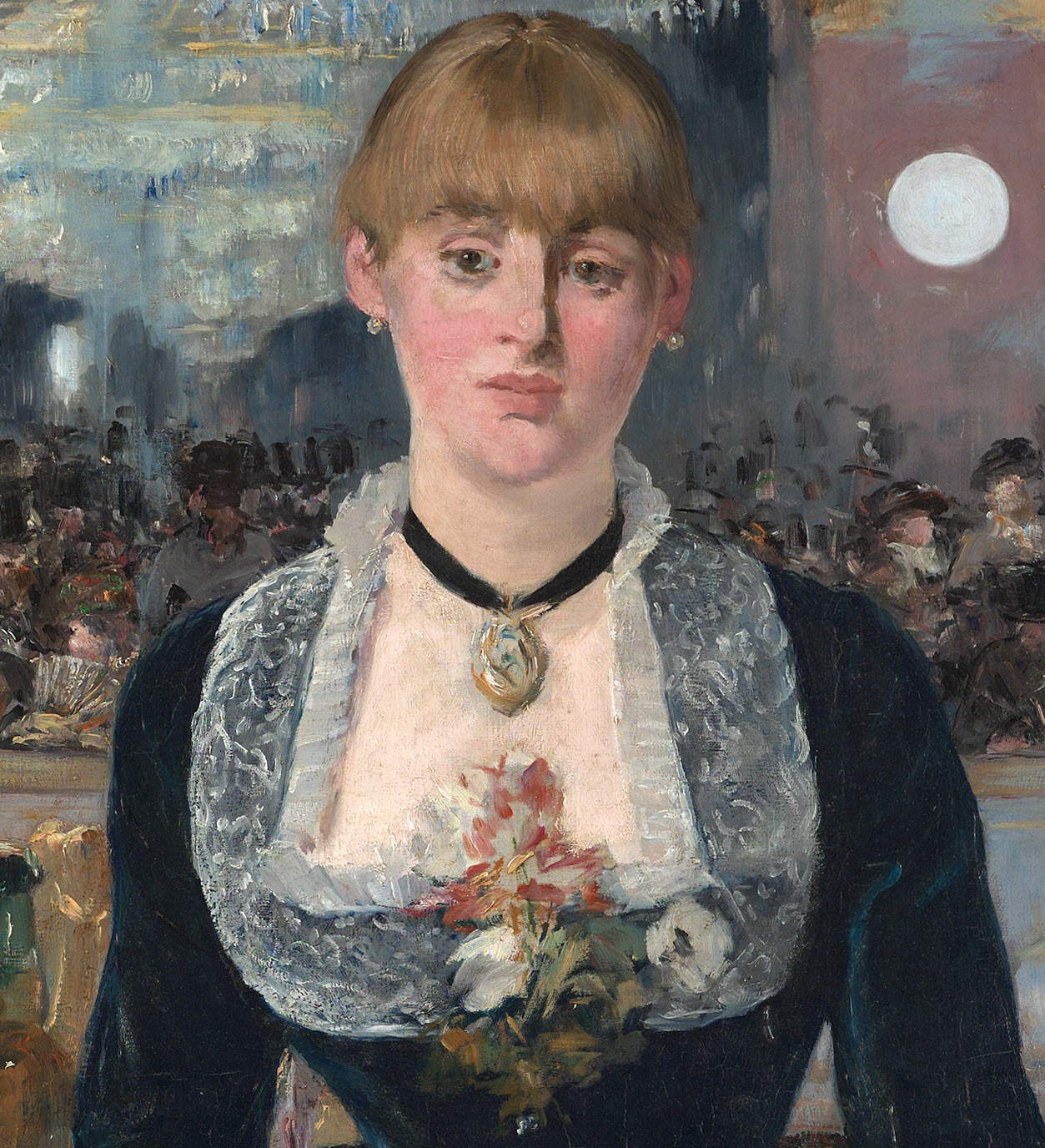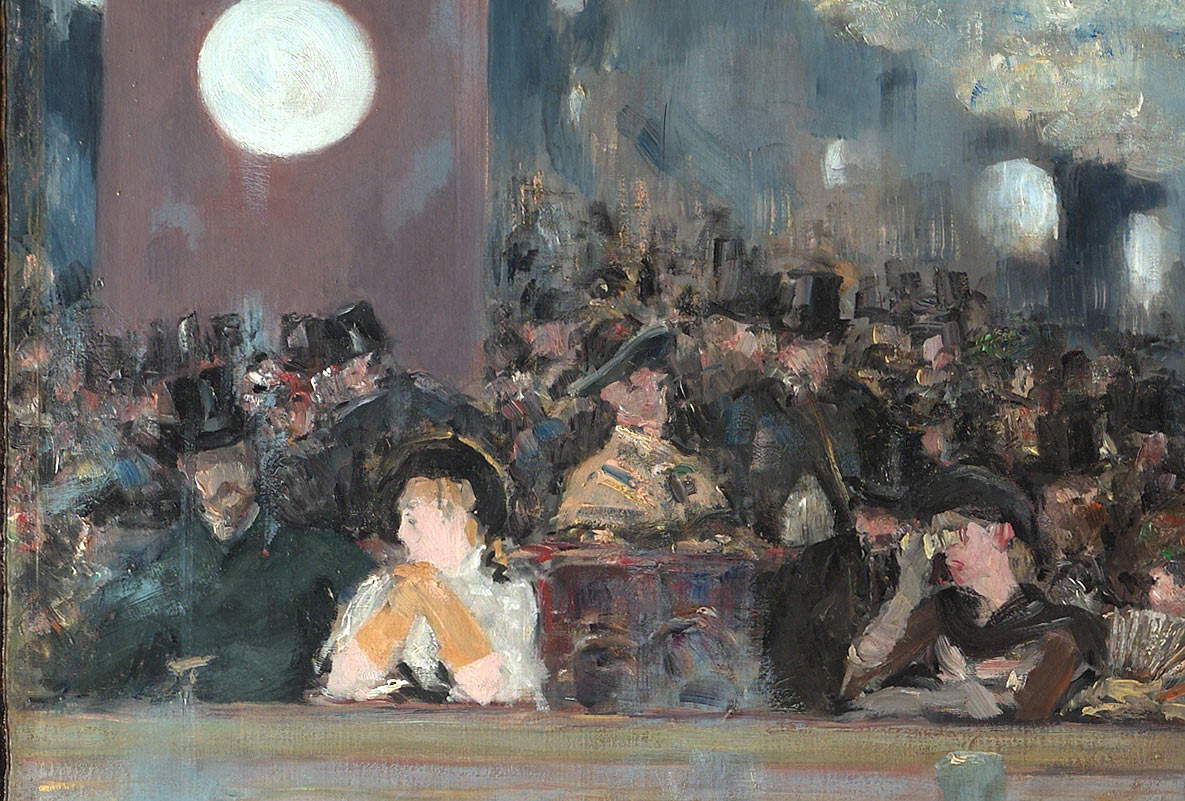We know that Édouard Manet (Paris, 1832 - 1883), one of the fathers ofImpressionism, used to frequent the Folies-Bergère in Paris , an establishment still in operation that defined itself as a hybrid formula of café, concert and theater, where Parisian bourgeois society gathered. Located in the ninth arrondissement, at 32 rue Richer, the café-concert was inaugurated on May 2, 1869, and its characteristic feature was that customers paid a kind of membership and paid for the drinks they consumed whenever they came to the venue, but inside it they could basically move about freely: they had the ability to come in and out whenever they wished, they could enjoy a show, drink, smoke and converse freely as they preferred. It specialized in variety shows: Notable actresses and dancers included Loïe Fuller, famous for her choreography in which she waved the veils in which she was totally enveloped and for her serpentine dance; Henri de Toulouse-Lautrec (Albi, 1864 - Saint-André-du-Bois, 1901), also a regular customer of the Folies-Bergère, depicted her in his works, while Manet did not have the opportunity to admire her on stage because the establishment cast her in 1892, when the painter had already passed away. Certainly, however, he had the opportunity to participate in the Parisian belle vivre, in the so-called vie bohémienne that was beginning to spread in the French capital at the end of the 19th century, and we know that the hall was also sometimes used for politically themed meetings: we know that in the winter of 1870-1871 Manet and Degas went to the Folies-Bergère, where citizens could listen to speeches by the historian Jules Michelet and the journalist and politician Henri Rochefort. Here, in short, one came into contact with the entire affluent society of the Belle Époque.
Probably without Madame Cornelie, a member of the Comédie-Française, the Folies-Bergère would never have existed, since until 1867 dancing, cross-dressing, and wearing accessories were strictly forbidden in the theaters, but everything changed when she wanted to perform in that very year in a café-concert and succeeded in having these restrictions repealed thanks to her friendship with a minister. Thus these clubs began to spread where one had the opportunity to dance, sing, dress up and recite lyrics in front of an audience. By the term "Folies,“ from the end of the eighteenth century, clubs for nightly parties with concerts, shows and ballets were meant, and from the 1830s in Paris theaters began to be called by the same term, and ”Folies" was followed by the name of the neighborhood in which they were located. The first director of the Folies Bergère then thought of naming the venue Folies Trévise (from the nearby rue de Trévise) or Folies Richer (from the name of the street where the venue was located), but both recalled family surnames with which it was not appropriate to associate the name of a performance hall, and so in the end Folies-Bergère was opted for , from the name of the nearby rue Bergère, which was not associated with the name of any family.

Although the theater of the Folies-Bergère still exists, Édouard Manet made it immortal by depicting it inhis last major painting, A Bar of the Folies-Bergère, which the Parisian artist completed in 1882, a year before his death. And in the same year he exhibited it at the Salon, the official annual exhibition of the French Academy of Fine Arts. Today it is instead kept at the Courtauld Gallery in London. In the center of the composition is portrayed a young barmaid elegantly attired in a black jacket that appears to be made of velvet that is very tightly fitted and fastened with a row of small ton sur ton buttons; the three-quarter sleeves are adorned with a lace trim at the hem, as is the trim of the wide square neckline with ruffles, and a floral decoration is noted on the breast. The girl wears a precious locket around her neck that hangs from a velvet ribbon the same color as the jacket. She has blond hair and bangs that soften her oval face with slightly flushed cheeks. The attire appropriate to an environment frequented by the bourgeoisie clashes slightly with the ungainly pose assumed by the bartender: the weight of her body is leaning forward, all dumped on the palms of her hands with which she leans against the white marble counter of the bar behind which she is depicted. The expression on her face is then significant because it suggests feelings of melancholy and sadness, and perhaps even signs of fatigue; it is adissatisfied expression with which the young woman addresses the viewer: in fact, she does not look straight into the eyes, but it is a lost look, of someone who would probably like to be anywhere but serving the customers of the café-concert. Although at first she seems to be addressing the observer, she is actually waiting for the request of the gentleman who can be seen reflected at the far right of the painting.
In fact, the painting presents a continuous play of reflections, where, moreover, perspective is totally ignored: on the right Manet has shifted the reflection of the girl; she is seen with her back turned as she addresses the elegant man in the hat. Behind her, but actually a reflection of what she sees in front, stands the entire audience of the Folies-Bergère: fashionably dressed ladies and gentlemen with hats and binoculars, in most cases with indefinite and incomplete faces, with a few exceptions, conversing with each other and at the same time attending the musical or circus performances offered. An example of the latter is the trapeze artist whose legs can only be seen sticking out in the upper left corner. Also hanging from the ceiling, as noted in the mirror, are large and precious chandeliers from which, however, no light seems to come; the lighting seems to be entrusted to those white roundels at the columns. Instead, still life pieces appear on the counter, consisting in particular of the glass with water to keep two roses cool and the riser with oranges, but also the bottles of wine, champagne, peppermint liqueur and Bass beer recognizable by the characteristic red triangle logo.



As already stated, Manet was very familiar with the bar; he only made a few sketches on the spot, but then produced the painting in his studio, where he literally staged the composition, moving and arranging the flowers, fruits, and bottles in the right position, and used as a model for the bartender a barmaid, Suzon, whom he knew well and invited to his studio to execute one of his greatest masterpieces. He told her to position herself behind a marble table, and called on his artist neighbor Gaston Latouche for the role of the reflected gentleman. In the crowd of spectators she also depicted portraits of real people existing in her present: several female figures have been recognized, for example, the lady dressed elegantly in white with yellow gloves sitting in the front row would be Méry Laurent, demi-mondaine and muse of numerous Parisian artists (she is said to have inspired Émile Zola to create the character of Dwarf); behind her is actress Jeanne de Marsy; the green boots sticking out in the upper left corner would probably belong to American trapeze artist Katarina Jones, who in 1881 performed at the Folies-Bergère to great public acclaim.
We see all these characters reflected in the mirror. It is a mirror that, as Charles Baudelaire wrote in his collection of essays Le Peintre de la vie moderne, published in 1863, a theoretical manifesto of modern art and criticism, “is as immense as the crowd; a kaleidoscope provided with consciousness which, with every movement of it, represents the multiplicity of life.”
Baudelaire used the term “modernity” to refer to the often ephemeral life of contemporary man within metropolises. Modernity is “the transitory, the fleeting, the contingent,” he said, and in fact one realizes that with the exception of the young bartender, all the people visible in the painting are the result of a vision reflected in a large mirror, and that therefore the reality depicted is not as stable as at first appearance, but rather is a play of mirrors and reflections. It is a world that superficially appears to have solid foundations, but when observed in depth is immersed inuncertainty and transience. Manet transferred to canvas a disorienting world built on appearance. This is why A Bar at the Folies-Bergère is considered one of the most iconic paintings depicting modern life.
Warning: the translation into English of the original Italian article was created using automatic tools. We undertake to review all articles, but we do not guarantee the total absence of inaccuracies in the translation due to the program. You can find the original by clicking on the ITA button. If you find any mistake,please contact us.